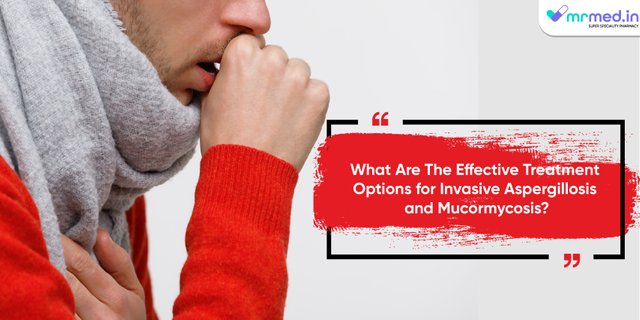What Are The Effective Treatment Options for Invasive Aspergillosis and Mucormycosis?

Fungal infections can range from mild, self-limiting conditions to severe, life-threatening diseases. Among the most serious are invasive aspergillosis and mucormycosis. These infections predominantly affect immunocompromised individuals, such as those undergoing chemotherapy, organ transplant recipients, or patients with uncontrolled diabetes.
The emergence of these infections necessitates effective antifungal treatments. This article explores the medications used to combat invasive aspergillosis and mucormycosis, with a focus on
Cresemba 100mg Capsule and Isavuconazole.
What are the stages of invasive aspergillosis?
Invasive aspergillosis is caused by the Aspergillus species, commonly found in soil, decaying plant matter, and indoor environments. When inhaled, Aspergillus spores can lead to severe lung infections, especially in those with weakened immune systems. Symptoms include fever, chest pain, coughing, and shortness of breath.
The stages of invasive aspergillosis are:
Colonisation: Aspergillus spores are inhaled and settle in the respiratory tract.
Early Invasion: The fungus begins to invade local tissues, causing localised infection in the lungs.
Angioinvasion: The fungus invades blood vessels, leading to tissue necrosis and possible dissemination to other organs.
Dissemination: The infection spreads beyond the lungs to other organs, such as the brain, heart, and kidneys, causing systemic infection and severe complications.
What is mucormycosis, and how quickly does it progress?
Mucormycosis, also known as zygomycosis, is a rare but serious fungal infection caused by a group of moulds called mucormycetes. These fungi live throughout the environment. Mucormycosis typically affects the sinuses, brain, or lungs and can rapidly become fatal if not treated promptly.
Mucormycosis progresses extremely quickly, often within a few days. If not treated promptly, it can cause severe tissue damage and systemic infection.
It can cause colour changes in affected tissues, which may indicate disease progression:
Early Stage: Redness and swelling at the infection site.
Intermediate Stage: Skin or mucosal areas may turn dark red or purple due to tissue necrosis and lack of blood flow.
Advanced Stage: The affected area may develop black, necrotic tissue, indicating severe tissue death and advanced infection.
How do you diagnose invasive aspergillosis?
Early diagnosis of invasive aspergillosis is critical for effective treatment. Here are some ways to diagnose:
Clinical Evaluation: Assess symptoms such as fever, cough, chest pain, and shortness of breath, especially in immunocompromised patients.
Imaging Studies: Conduct chest X-rays and CT scans to identify characteristic signs in the lungs, such as halo or crescent signs.
Microbiological Tests: Obtain and examine respiratory samples (sputum, bronchoalveolar lavage) for the presence of Aspergillus species via culture or microscopic analysis.
Serological Tests: Perform blood tests to detect Aspergillus antigens, such as galactomannan or beta-D-glucan assays.
Histopathological Examination: Biopsy the affected tissue and conduct histological analysis to observe fungal hyphae invading the tissue, confirming the diagnosis.
What is the first-line treatment for invasive aspergillosis?
The treatment of invasive aspergillosis typically involves an initial intensive phase followed by a maintenance phase. Cresemba's dosing regimen, starting with a loading phase, ensures rapid attainment of therapeutic drug levels. This approach helps to control the infection and prevent its spread quickly.
How is mucormycosis identified?
Mucormycosis requires a high index of suspicion for early diagnosis, given its rapid progression and high mortality rate. Diagnostic approaches include histopathological examination and culture of clinical specimens.
Imaging Studies: Conduct imaging studies, such as CT or MRI scans, to detect signs of tissue invasion and sinus or lung involvement.
Microbiological Tests: Obtain and examine samples from the affected area (sinus tissue, lung aspirates) for the presence of mucormycetes via culture or microscopic analysis.
Histopathological Examination: Biopsy the affected tissue and perform histological analysis to identify characteristic broad, ribbon-like, aseptate fungal hyphae.
Molecular Diagnostics: Utilize PCR and other molecular techniques to detect mucormycete DNA in clinical specimens for rapid and accurate diagnosis.
Treatment Protocols
The standard treatment for mucormycosis includes antifungal therapy with Isavuconazole, as found in the Cresemba 100mg capsule Due to its broad-spectrum activity, Isavuconazole is effective against various mucormycetes. The dosing regimen follows a similar pattern to that used for invasive aspergillosis, ensuring adequate drug levels to control the infection.
Monitoring and Managing Side Effects
While Isavuconazole is generally well-tolerated, monitoring for potential side effects is essential. Common side effects include gastrointestinal disturbances, headache, and elevated liver enzymes. Regular monitoring of liver function tests and renal function is recommended during treatment.
Parting Words
Invasive aspergillosis and mucormycosis are life-threatening fungal infections requiring prompt and effective treatment. Cresemba 100mg Capsule, containing Isavuconazole, provides a robust antifungal option for managing these conditions. Its broad-spectrum activity, favourable safety profile, and convenient dosing regimen make it a valuable addition to the antifungal armamentarium.